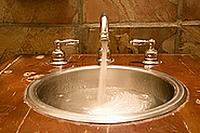|
The Water Supply System
The water supply system brings water into the home from either a private well or municipal water source. Water arrives into the house by what is called the "main". This is a main line that enters into the house from the street or well and then branches off. One line goes into the hot water heater and the other to the cold water supply lines of your fixtures and appliances. The line that goes into the hot water heater exits through an outgoing line that supplies hot water to the fixtures and appliances. These lines usually range in size from 3/4" to 1". They then size down to usually a 1/2" feed to the fixture or appliance. Unlike your drainage system, the supply lines are pressurized. The water main entrance is where you will also find the main shut off valve for your home. This is important to know in the event of an emergency as normal water pressure flows at an average of 50 - 60 p.s.i (pounds per square inch). This can result in a lot of water flooding very quickly into your home or basement. Additionally when you are renovating, be sure your plumber is installing stop valves at all the new fixtures and appliances. This will give you more flexibility in the event of a problem; you may not have to shut the whole house down. Low Water PressureAs discussed above, the average household's pressure is 50 - 60 p.s.i. There are numerous reasons that your pressure may be low or drop at times. Below is a partial list of the most frequent.
Other than checking the valves to be sure they are open all the way and checking an aerator for clogs, a plumbing professional should be called in to find the problem. They will then be able to tell you what your options are. If recommended, you may also have to call in your local water works to perform some tests restricted by code for you or your plumber. Problems at the Source
If it is determined that the problem is at the source, there are a couple of solutions. If you have municipal water supplied, check with them to see if they will increase the size of the line feeding your home's water supply. This is usually only allowed if you and your plumber can prove just cause that an increase is warranted. Another option is to install a booster pump which will help increase the amount of water flowing to your fixtures and appliances. This pump is located on the inside of the main supply after the water meter. If you have a well as your water supply, you can increase the size of the line but you should make sure that your well pump can handle the increase as well as the well itself. The last thing you need is to have it run dry. Your plumber should be able to assist you with all of these solutions including acting as an intermediary with your local water supply board. Return from Water Supply to DIY Heating and Plumbing
|
